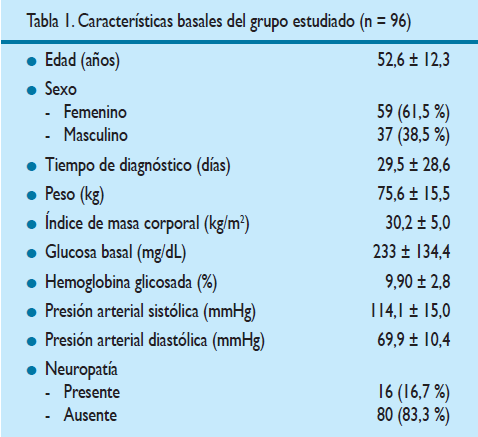Prevalence and risk factors of diabetic peripheral neuropathy in newly diagnosed patients of diabetes mellitus attending at national hospital
DOI:
https://doi.org/10.36393/spmi.v32i1.14Keywords:
diabetes mellitus type 2, neuropathy, prevalence, risk factorsAbstract
ObjeCtive. To determine the prevalence and risk factors of diabetic peripheral neuropathy (DPN) in newly diagnosed patients of diabetes mellitus (DM2) attending Hospital Nacional Arzobispo Loayza (HNAL). Material and MethOds. Prospective, cross-sectional analytical study in patients attending the Endocrinology Service of HNAL, Lima. Inclusion criteria were a recent diagnosis (less than 3 months) of DM2 according to ADA criteria and age ≥18 years old. Patients with gestational diabetes, secondary diabetes, history of non-DPN and those in hyperglycemic crises were excluded. DPN was evaluated using a biothesiometer and was defined as the presence of a vibration perception threshold greater than 25 V in the plantar region of the first toe of at least one of the feet. To describe the characteristics of the population, frequencies and percentages were used for categorical variables, mean and standard deviation (SD) were used for continuous variables. The prevalence of DPN was calculated using frequency and
percentage and chi-square was used to explore potential factors related to diabetic neuropathy. We used generalized linear models, Poisson family to estimate crude and adjusted prevalence ratios and
their respective 95 % confidence intervals (95%CI). results. 96 patients were enrolled, with a mean age of 52,6 years (SD ± 12,3) and 59 of them females (61,5 %). Mean body mass index was 30,2 kg/m2
(SD ± 5,0) and mean HbA1c was 9,9 % (SD ± 2,8 %). Mean systolic blood pressure and mean diastolic blood pressure were 114,1 mmHg (SD ± 15,0) and 69,9 mmHg (SD ± 10,4) respectively. DPN was found in
16 patients (16,7 %). Being older than 60 years was associated with a higher prevalence of diabetic neuropathy. Having as outcome DPN, the prevalence ratio of age ≥ 60 years compared to age < 60
years was 4,86 (95%CI 1,69-13,9). In the model adjusted for gender and HbA1c > 8 %, the prevalence ratio for age ≥ 60 years was 5,24 (95%CI 1,82-15,12). COnClusiOns. Our study, the first of its kind
in our country and the second in Latin America, found that almost two out of 10 people with DM2 already have peripheral diabetic neuropathy at the time of diagnosis and that the prevalence of
this condition is five times higher in patients over 60 years old compared to younger patients. This emphasizes the need to perform a screening for diabetic neuropathy starting at the time of
diagnosis of DM2, especially in the population over 60 years of age, to ensure early adequate foot care and glycemic control.
Downloads















